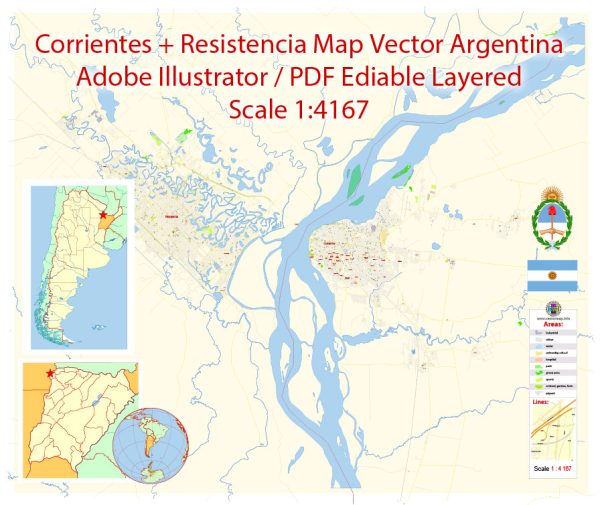The city of Resistencia is the capital and largest city of the Chaco Province in Argentina, located in the northeastern part of the country. Its history of urban development is closely tied to the broader historical, social, and economic context of the region.
Early History: The indigenous people, such as the Qom (Tobas) and Pilagás, inhabited the Chaco region for centuries before the arrival of European colonizers. The Spanish colonization of the area began in the 16th century, and it gradually became part of the Spanish Viceroyalty of Peru. However, the Chaco remained relatively isolated and sparsely populated for a long time.
19th Century: In the 19th century, as Argentina gained independence from Spanish rule, efforts were made to integrate and develop the country’s interior regions. The Chaco saw increased European immigration and attempts at colonization. Resistencia, initially a small settlement, began to grow as a result of agricultural activities and the expansion of transportation routes, such as the railway.
20th Century: Resistencia’s urban development gained momentum in the 20th century. The city was officially founded on August 27, 1878, but it experienced significant growth in the mid-20th century. The construction of key infrastructure, such as roads and bridges, facilitated economic activities and migration to the region. The city became a hub for trade and commerce, particularly in relation to the agricultural products of the surrounding area.
Modern Era: In recent decades, Resistencia has continued to evolve as an important urban center. The city has seen improvements in infrastructure, including modern buildings, parks, and cultural facilities. The urban planning of Resistencia often reflects a mix of contemporary architecture and efforts to preserve its historical and cultural heritage.
Cultural and Architectural Features: Resistencia is known for its commitment to cultural expression, and this is evident in the city’s architecture and public spaces. The city is famous for its open-air sculptures, murals, and cultural events. One of the most significant events is the Bienal Internacional de Esculturas, which brings together artists from around the world to create sculptures that are displayed in public spaces.
Economic Influence: Economically, Resistencia plays a crucial role in the region, serving as a center for commerce, services, and administration. Its economic development is closely tied to the agriculture and livestock activities in the surrounding Chaco Province.
Challenges and Future Development: Like many growing urban areas, Resistencia faces challenges related to infrastructure, urban planning, and social development. Efforts are ongoing to address issues such as housing, transportation, and environmental sustainability while preserving the city’s cultural identity.
In summary, Resistencia’s history of urban development reflects the broader trends of Argentina’s interior regions, with a trajectory shaped by colonization, agricultural activities, infrastructure development, and a commitment to cultural expression. The city continues to evolve as it faces the challenges and opportunities of the modern era.


 Author: Kirill Shrayber, Ph.D.
Author: Kirill Shrayber, Ph.D.